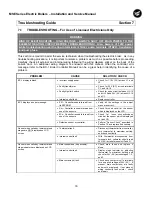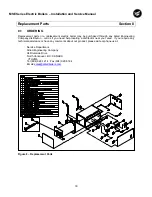
MSE Series Electric Boilers – Installation and Service Manual
17
PROBLEM
CAUSE
SOLUTION / CHECK
•
Flow Switch is open
•
Check for closed circuit between FS-5
and FS-6 and 24V (AC) across FS-6
and C-1.
•
Element fault.
RISK OF ELECTROCUTION! – MAIN
POWER TO ELEMENTS MUST BE
DISCONNECTED! Next, disconnect
element wires from main contactor(s)
and check for continuity. If no
continuity, replace element. If
continuity, the contactor is defective.
(To confirm contactor defect, check for
continuity across main contactor when
closed.)
Pump runs constantly when there is no
call for heat.
•
Internal control fault.
•
Replace controller.
•
Pump ceased or burnt out.
•
Repair or replace.
•
Pump wiring fault.
•
Check and repair wiring.
•
Pump fuse blown.
•
Check pump fuse and replace if
necessary.
Pump will not run.
•
Internal control fault.
•
Replace controller.
Controller does not operate normally.
•
Internal control fault.
•
Replace controller.
•
Relief valve not reseating properly.
•
Quickly lift and release manual
discharge lever on relief valve to assist
proper reseating. If this fails, replace
pressure relief valve.
Pressure relief valve discharges water.
•
Pressure reducing valve set too high.
•
Reduce setting of pressure reducing
valve.
•
Element or sensor threads leaking.
•
Turn off all electricity to the boiler.
Remove wires from element terminals
and tighten elements (with correct
socket wrench). Turn off water, drain,
remove and apply sealant if necessary.
Water leaking from electric boiler.
•
Plumbing connections leaking.
•
Tighten incoming pipes and pressure
relief valve. Turn off water, drain and
remove and apply sealant if necessary.
(Be sure to turn off electricity before
draining or elements will burn out.)
7.2 SENSOR
CHECK
1.
SHUT OFF MAIN POWER TO THE ELEMENT HEATING CIRCUIT BEFORE TROUBLESHOOTING!
2. Confirm correct sensor wiring. Refer to the wiring diagram sticker on the back of the boiler front
casing panel.
3. Make sure there is no power applied to the controller before measuring resistance.
4. To test for a defective sensor, measure the resistance directly at the sensor location. The resistance
should be roughly 12000 ohms at room temperature (68
°
F). For other temperatures and their
corresponding resistance readings, refer to the
BC-1 Controller Manual
.
5. If the meter reads a very high resistance, there may be a broken wire, a poor wiring connection or a
defective sensor. If the resistance is very low, the wiring may be shorted, there may be moisture in
the sensor or the sensor may be defective.




































